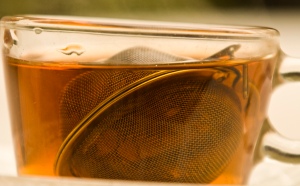 Boldo (Peumus boldus Molina, the only species in the genus Peumus) is a tree native to the central region of Chile, occurring from 33 to 40° South Latitude. Together with litre, quillay, peumo, bollén and other indigenous plants, it is a characteristic component of the sclerophyllous forest (hard leaves that resist long dry summers and cold rainy winters) endemic to central Chile. Its leaves, which have a strong, woody and slightly bitter flavor and camphor-like aroma, are used for culinary purposes, primarily in Latin America. The leaves are used in a similar manner to bay leaves, and also used as an herbal tea, primarily in Chile, Argentina, Paraguay, Peru, Uruguay, Brazil and bordering countries in South America. Boldo has also been introduced to Europe and North Africa.
Boldo (Peumus boldus Molina, the only species in the genus Peumus) is a tree native to the central region of Chile, occurring from 33 to 40° South Latitude. Together with litre, quillay, peumo, bollén and other indigenous plants, it is a characteristic component of the sclerophyllous forest (hard leaves that resist long dry summers and cold rainy winters) endemic to central Chile. Its leaves, which have a strong, woody and slightly bitter flavor and camphor-like aroma, are used for culinary purposes, primarily in Latin America. The leaves are used in a similar manner to bay leaves, and also used as an herbal tea, primarily in Chile, Argentina, Paraguay, Peru, Uruguay, Brazil and bordering countries in South America. Boldo has also been introduced to Europe and North Africa.
Peumus Boldus, is an evergreen, fragrant shrub, from 15 to 20 feet high, and native of the mountainous regions of Chile. The leaves are opposite, coriaceous, and on leaf-stalks about 1/4 inch in length. The flowers are in loose, terminal, dioecious cymes of about 12 flowers each, on slender, pubescent pedicles. The petals are generally 7, strap-shape, and about 1/2 inch long, of a light-yellow color, and somewhat twisted. The male flower has numerous recurved stamens, with slender filaments, which are hairy at the base. The fruit is a small orange-green, 1-seeded drupe, which is aromatic and edible.
 In 1782, Molina described this shrub, under the name Peumus Boldus; in 1794, Ruiz and Pavon described the same plant under the name Ruizia fragrans; in 1809, Jussieu classed the plant under the name of Boldoa fragrans; finally, in 1869, M. H. Baillon presented a complete history of the plant under the name Peumus Boldus, which name it still retains. Boldo was introduced to the profession by Dujardin-Beaumetz and C. L. Verne, about 1872, and in the same year E. Bourgoin and C. Verne obtained from the leaves a volatile oil, and an alkaloid to which the name boldine or boldina, was given. The plant also contains essential oil, citric acid, lime, sugar, gum, tannin, and a quantity of thick, black, aromatic substances, probably due to oxidation of the oil; these constituents have no medicinal virtues. Boldoglucin, a narcotic alkaloid, was isolated by Chapoteaut.
In 1782, Molina described this shrub, under the name Peumus Boldus; in 1794, Ruiz and Pavon described the same plant under the name Ruizia fragrans; in 1809, Jussieu classed the plant under the name of Boldoa fragrans; finally, in 1869, M. H. Baillon presented a complete history of the plant under the name Peumus Boldus, which name it still retains. Boldo was introduced to the profession by Dujardin-Beaumetz and C. L. Verne, about 1872, and in the same year E. Bourgoin and C. Verne obtained from the leaves a volatile oil, and an alkaloid to which the name boldine or boldina, was given. The plant also contains essential oil, citric acid, lime, sugar, gum, tannin, and a quantity of thick, black, aromatic substances, probably due to oxidation of the oil; these constituents have no medicinal virtues. Boldoglucin, a narcotic alkaloid, was isolated by Chapoteaut.
Boldo leaves are a good substitute for Indian bay leaves, which are necessary for Northern Indian kormas and form an ingredient for the spice mixture garam masala. Since boldo leaves are rather strong, amounts should be slightly reduced. In Western cuisine, boldo leaves may substitute the common bay leaves; adjust dosage if necessary. Boldo leaves are best suited for fish; furthermore, they may enrich tasty sauces and gravies. Similar to savory, they are well suited for mushrooms. Another application is pickled vegetables. One report says that the plant succeeds outdoors at Kew Gardens in London, where it often flowers all year round. Whoever has tried these strongly aromatic leaves, will most probably make them a permanent ingredient in his or her cooking.
Source: henriettesherbal.com
Ingredients
2g dried boldo leaf
300ml boiling water
Instructions
This is a tea commonly used in Mexico and South America to calm the stomach. In Mexico fresh leaves are typically used, but in Argentina this comes as tea-bags of dried leaf.
Pour boiling hot water into a teacup. Place tea leaves into your tea ball, according to the instructions. Close the tea ball and place it in the teacup. Cover up and and steep your tea for 3 to 5 minutes to get the full flavor. Remove the tea ball after the tea has finished steeping. Sweeten to taste with honey and drink.




























katespade saturday
I am drinking this and it helps my stomach good